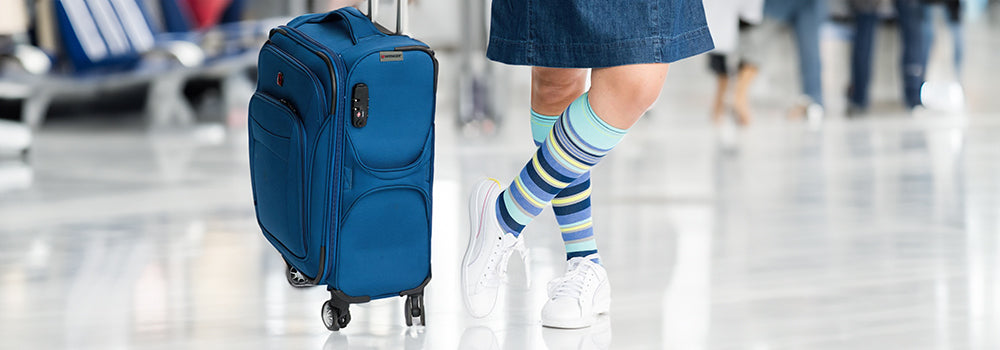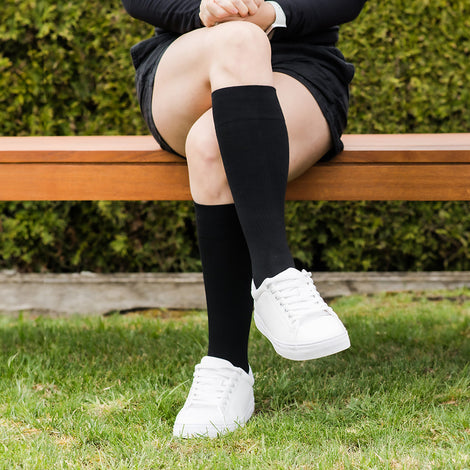Long Flights and Swollen Feet: How to Stay Comfortable While Traveling

Traveling, especially during long flights, can be exciting but also physically taxing. One common problem many travelers experience is swollen feet and legs due to prolonged sitting. When you remain seated for hours, blood circulation in your lower body slows down, causing fluid to pool in your legs and feet. Fortunately, there are effective ways to prevent this uncomfortable and sometimes painful condition.
In this guide, we’ll explore why swelling during flights happens and provide practical tips, including the benefits of wearing compression socks, to help you stay comfortable and healthy while traveling.
Why Do Your Feet Swell on Long Flights?
Swollen feet, or edema, is a common issue when traveling, especially during flights that last several hours. This happens because:
- Reduced blood circulation: Sitting for extended periods with limited leg movement slows down blood flow, especially in the lower legs and feet.
- Airplane cabin pressure: The pressurized cabin of an airplane can cause fluid retention, making swelling more likely.
- Dehydration: Airplane cabins are dry, leading to dehydration, which makes your body retain water, further contributing to swelling.
- Prolonged sitting: Staying in a seated position for long hours can compress your veins, making it harder for blood to circulate back to your heart.
Now that we understand the causes, let’s dive into solutions.
1. Wear Compression Socks
One of the most effective ways to combat swollen feet and legs during long flights is to wear compression socks. Compression socks apply gentle pressure to your legs, promoting better blood flow and preventing fluid from pooling in your lower limbs.
By wearing compression socks, you can:
- Improve circulation: Compression socks help move blood back up toward your heart, reducing the risk of swelling and discomfort.
- Prevent blood clots: Long flights can increase the risk of deep vein thrombosis (DVT), a serious condition where blood clots form in the veins of your legs. Compression socks can reduce this risk by promoting healthy blood circulation.
- Increase comfort: Compression socks provide all-day support, reducing leg fatigue and swelling, so you arrive at your destination feeling refreshed.
For best results, choose compression socks with a compression level of 15-20 mmHg, which is ideal for travel. Make sure to wear them before boarding the plane and keep them on throughout the flight.
Top Tip: Dr. Johnny’s compression socks are designed for long-term comfort and travel, providing seamless, non-binding support to keep your legs feeling light and energized.

2. Stay Hydrated
Dehydration can worsen fluid retention, so it’s crucial to drink plenty of water before and during your flight. Avoid alcohol and caffeine, as both can dehydrate your body and contribute to swelling.
Drinking water helps:
- Maintain fluid balance: Staying hydrated reduces the chance of fluid retention in your legs and feet.
- Support circulation: Proper hydration keeps your blood thin and flowing freely, reducing the risk of clots and swelling.
Top Tip: Aim to drink 8-12 ounces of water for every hour of your flight.
3. Move Around Frequently
Sitting still for too long is one of the biggest contributors to swollen feet and poor circulation during flights. Try to move as much as possible to keep blood flowing.
Here are a few ways to stay active while traveling:
- Get up and walk: Take a walk down the aisle every hour or so to stimulate blood flow in your legs.
- Do seated exercises: Even if you can’t get up, you can still perform simple stretches while seated. Try ankle rolls, calf raises, and flexing your feet to encourage circulation.
- Stretch before the flight: Pre-flight stretching can also help improve blood flow and reduce the likelihood of swelling.
Top Tip: Set a timer on your phone as a reminder to move every hour during long flights.
4. Wear Comfortable Clothing
Tight clothing can restrict circulation, especially around your waist, thighs, and calves. When traveling, opt for loose, breathable fabrics that allow your blood to flow freely.
Avoid:
- Tight socks: Regular socks with tight elastic bands can worsen swelling by restricting blood flow around your ankles.
- Skinny jeans or tight pants: Choose more relaxed clothing that allows for better movement and circulation.
Top Tip: Pair your loose clothing with compression socks to maximize comfort and reduce the risk of swollen feet.
5. Elevate Your Feet if Possible
Whenever possible, elevate your feet slightly to encourage blood flow back toward your heart. You can use a small carry-on bag or a travel pillow under your feet to keep them raised. This simple action can significantly reduce swelling during the flight.
Top Tip: While seated, try to avoid crossing your legs, as this can further reduce circulation and contribute to leg swelling.
6. Flex and Stretch Your Feet
Even small movements can make a big difference during long flights. Try these simple exercises to keep your blood moving:
- Ankle rotations: Rotate your ankles in circles to stimulate blood flow.
- Toe flexes: Point and flex your toes to engage your calf muscles and improve circulation.
- Heel-to-toe pumps: Press your heels into the floor, then lift your toes. Alternate between toes and heels to engage your leg muscles.
Perform these exercises every hour to help prevent swelling.
7. Use a Footrest or Travel Pillow
Using a travel footrest or a pillow to prop up your feet can help improve circulation, especially if your feet don’t touch the floor when seated. Elevating your legs slightly reduces the pressure on your veins and helps minimize swelling.
Top Tip: Compression socks combined with regular foot flexes and an elevated foot position offer maximum relief during long-haul flights.
Conclusion: Stay Comfortable and Healthy on Your Next Flight
Long flights can be tough on your body, but by following these tips, you can significantly reduce swollen feet and improve your travel experience. Wearing compression socks, staying hydrated, and moving frequently are the best ways to maintain good circulation and prevent discomfort.
So, next time you travel, pack a pair of Dr. Johnny’s compression socks and make your journey a lot more comfortable. Whether you're traveling for work or leisure, healthy feet make all the difference in how you feel when you land.
SHARE:




